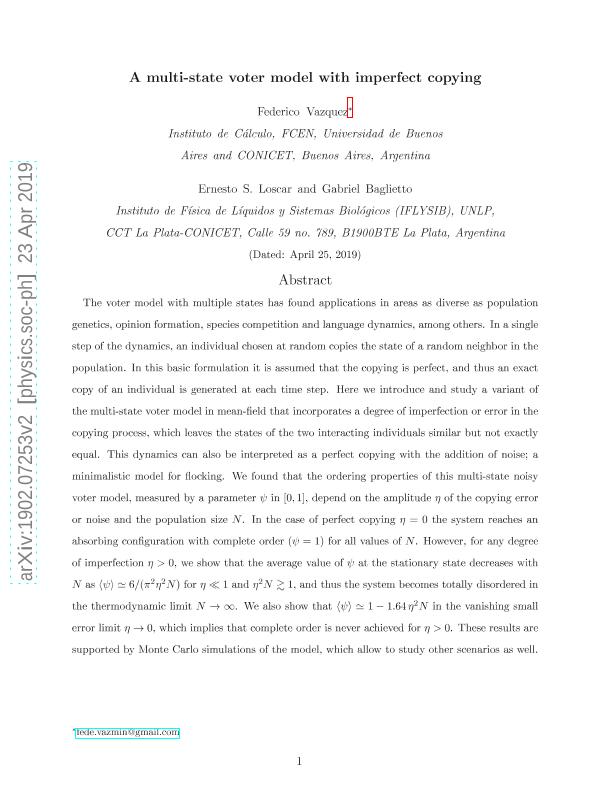Mostrar el registro sencillo del ítem
dc.contributor.author
Vazquez, Federico

dc.contributor.author
Loscar, Ernesto Selim

dc.contributor.author
Baglietto, Gabriel

dc.date.available
2021-10-07T15:57:27Z
dc.date.issued
2019-10
dc.identifier.citation
Vazquez, Federico; Loscar, Ernesto Selim; Baglietto, Gabriel; Multistate voter model with imperfect copying; American Physical Society; Physical Review E; 100; 4; 10-2019; 1-46
dc.identifier.issn
2470-0053
dc.identifier.uri
http://hdl.handle.net/11336/143150
dc.description.abstract
The voter model with multiple states has found applications in areas as diverse as population genetics, opinion formation, species competition, and language dynamics, among others. In a single step of the dynamics, an individual chosen at random copies the state of a random neighbor in the population. In this basic formulation, it is assumed that the copying is perfect, and thus an exact copy of an individual is generated at each time step. Here, we introduce and study a variant of the multistate voter model in mean field that incorporates a degree of imperfection or error in the copying process, which leaves the states of the two interacting individuals similar but not exactly equal. This dynamics can also be interpreted as a perfect copying with the addition of noise: a minimalistic model for flocking. We found that the ordering properties of this multistate noisy voter model, measured by a parameter ψ in [0,1], depend on the amplitude η of the copying error or noise and the population size N . In the case of perfect copying η = 0 , the system reaches an absorbing configuration with complete order ( ψ = 1 ) for all values of N . However, for any degree of imperfection η > 0 , we show that the average value of ψ at the stationary state decreases with N as ⟨ ψ ⟩ ≃ 6 / ( π 2 η 2 N ) for η ≪ 1 and η 2 N ≳ 1 , and thus the system becomes totally disordered in the thermodynamic limit N → ∞ . We also show that ⟨ ψ ⟩ ≃ 1 − π 2 6 η 2 N in the vanishing small error limit η → 0 , which implies that complete order is never achieved for η > 0 . These results are supported by Monte Carlo simulations of the model, which allow to study other scenarios as well.
dc.format
application/pdf
dc.language.iso
eng
dc.publisher
American Physical Society

dc.rights
info:eu-repo/semantics/openAccess
dc.rights.uri
https://creativecommons.org/licenses/by-nc-sa/2.5/ar/
dc.subject
Complex Systems
dc.subject
Nonequilibrium statistical Mechanics
dc.subject
Active Matter
dc.subject
Social Systems
dc.subject.classification
Otras Ciencias Físicas

dc.subject.classification
Ciencias Físicas

dc.subject.classification
CIENCIAS NATURALES Y EXACTAS

dc.title
Multistate voter model with imperfect copying
dc.type
info:eu-repo/semantics/article
dc.type
info:ar-repo/semantics/artículo
dc.type
info:eu-repo/semantics/publishedVersion
dc.date.updated
2020-11-19T21:54:28Z
dc.journal.volume
100
dc.journal.number
4
dc.journal.pagination
1-46
dc.journal.pais
Estados Unidos

dc.journal.ciudad
New York
dc.description.fil
Fil: Vazquez, Federico. Consejo Nacional de Investigaciones Científicas y Técnicas; Argentina. Universidad de Buenos Aires. Facultad de Ciencias Exactas y Naturales. Instituto de Cálculo; Argentina
dc.description.fil
Fil: Loscar, Ernesto Selim. Consejo Nacional de Investigaciones Científicas y Técnicas. Centro Científico Tecnológico Conicet - La Plata. Instituto de Física de Líquidos y Sistemas Biológicos. Universidad Nacional de La Plata. Facultad de Ciencias Exactas. Instituto de Física de Líquidos y Sistemas Biológicos; Argentina
dc.description.fil
Fil: Baglietto, Gabriel. Consejo Nacional de Investigaciones Científicas y Técnicas. Centro Científico Tecnológico Conicet - La Plata. Instituto de Física de Líquidos y Sistemas Biológicos. Universidad Nacional de La Plata. Facultad de Ciencias Exactas. Instituto de Física de Líquidos y Sistemas Biológicos; Argentina
dc.journal.title
Physical Review E

dc.relation.alternativeid
info:eu-repo/semantics/altIdentifier/url/https://journals.aps.org/pre/abstract/10.1103/PhysRevE.100.042301
dc.relation.alternativeid
info:eu-repo/semantics/altIdentifier/doi/http://dx.doi.org/10.1103/PhysRevE.100.042301
dc.relation.alternativeid
info:eu-repo/semantics/altIdentifier/url/https://arxiv.org/abs/1902.07253v2
Archivos asociados
